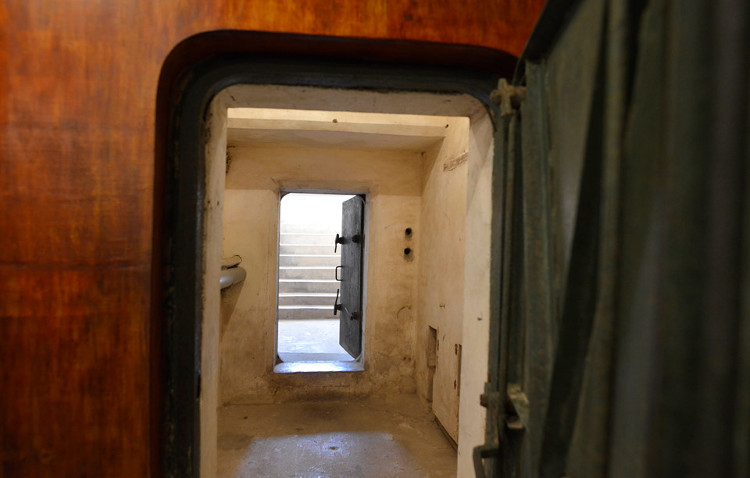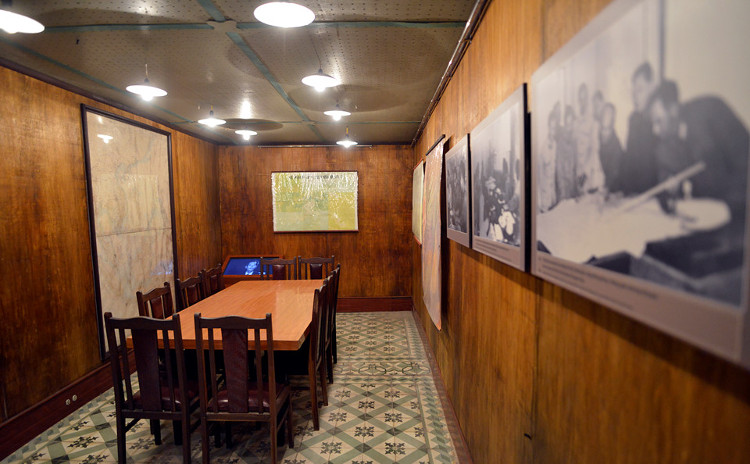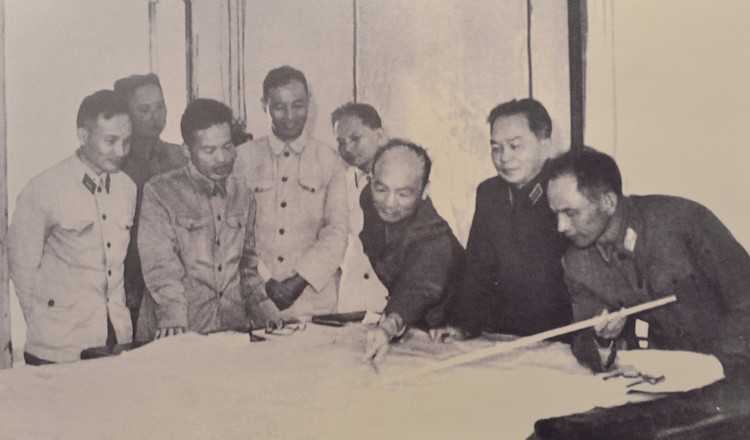Close up of the atomic bomb combat operation tunnel in Hanoi
T1 Tunnel is located under the Operation Bureau building within the Thang Long Royal Citadel Center which is able to resist the destructive power of blockbusters and missiles.

Thang Long Heritage Conservation Center (Hanoi) organizes an exhibition to introduce T1 combat tunnel of the General Staff Department under the General Headquarters of the Vietnam People's Army.

After 45 years, the public can see images and artifacts as well as the entire structure of the tunnel.T1 Tunnel was built in late 1964 and early 1965, right from the early days of the US war to destroy the North, designed and constructed by Regiment 259 (Department of Military Engineering).During the construction process, the General Staff decided to demolish the second floor of the Operation Department, creating disguised rubble, avoiding the detection of spy planes.

The tunnel is divided into 3 rooms, total area 64m 2 , cast in monolithic reinforced concrete (about 1,000m 3 ). The tunnel is raised from the ground 1.5m and divided into 3 layers, half a meter thick in the middle. The bunker can withstand the destructive power of blockbusters and air-to-surface missiles, surviving through an atomic attack, chemical weapons, and germs. In the picture is the 20m 2 wide meeting room, the working place of the head of department, is responsible for synthesizing the latest situation of the ministries, receiving orders and reporting the situation to the higher levels.

The division of operations was the place where senior leaders of the Party, the State, the army came to work, commanded during the two wars of destroying the North of the American empire.The Politburo, the Military Commission of the Central Committee, the commander-in-chief have worked at T1 tunnel for over 7,000 days and nights with more than 1,000 important meetings.In the photo, Deputy Chief of Staff and members of the Air Defense Command - Air Force presented the plan to protect Hanoi's airspace with General Vo Nguyen Giap.

During the second US sabotage war in 1972, the commanding tunnel was at the same time carrying out three major tasks: The commander shot down many American planes;ensure hospital spending for the South;organizing people's air defense battles.

The operational battle room of 43m 2 is a 24/24-hour working place of the combat crew, which is undertaken by the Operation Department, the General Staff Department, and directly responds to President Ho Chi Minh when the Caller , ask, monitor the situation of defending the North (on land, sea, air) and fighting on Indochina battlefields.

The combat operation room is invested synchronously with 4 cabins (each cabin commands 1 front, equipped with 3 telephones run by a direct person).
Kip also has the responsibility to propose to the General Staff Department of combat strategies to respond promptly

, take the initiative to win the battle on the battlefield, synthesize the situation every day, and report to the Defense Minister and the Chief of the General Staff each week during the briefing every morning.

For Hanoi Capital, the crew must alert the people 's air defense promptly and accurately;informing the militant developments to the leaders of the Party, the State, Ho President and quickly reporting the fighting results of the people as well as the damage caused by the enemy in the North, in Hanoi.

Phone number 1, online to answer President Ho Chi Minh when the Caller asked.

The historical artifacts used in the tactical command in the T1 tunnel are preserved.

Images simulating the members in the crew, wearing headphones and determining the exact coordinates of the enemy B52 aircraft.

Set of teapots, flashlights and some equipment used daily in T1 tactical command tunnel.

The last room in the cellar is the room where the equipment and engines are 10 meters wide, near the tunnel in the south.This is the place to operate ventilation, poisoning, cooling, telegraphy systems . to ensure technical support for 28 phones in smooth communication tunnels and crews (about 10 people) throughout the day. night.

After 1975, this cellar was almost unused.In 2012, the tunnel was renovated, repaired and in 2017 officially opened to visitors.

In addition, this area also exhibited many artifacts about the resistance against the American army of Hanoi.In the photo is the B52 bomb shell at the exhibition area next to the T1 tactical command tunnel.

Straw hats of the Hanoi army and people in the exhibition celebrating 45 years of Hanoi - Dien Bien Phu victory over the air.
- The man 2 times the atomic bomb did not die
- Decipher the mystery where the US built an atomic bomb
- The object was amazingly intact after the atomic bomb explosion in Hiroshima
- The world's largest atomic bomb explosion 54 years ago
- 'Devil's core', the cursed heart of the third atomic bomb dropped on Japan
- Results if atomic bombs explode in the deepest ocean trench
- The attempt to have an American plane to lose an atomic bomb
- The secret base for making China's first atomic bomb
- Decode the most terrible atomic bomb series in history
- 10 unforgettable photos of atomic bomb explosions
- The shocking truth about the 'father' of the atomic bomb
- Plutonium: The twin brother of Uranium
 The 11 most unique public toilets in the world
The 11 most unique public toilets in the world Explore the ghost town in Namibia
Explore the ghost town in Namibia Rare historical moments are 'colored', giving us a clearer view of the past
Rare historical moments are 'colored', giving us a clearer view of the past The world famous ghost ship
The world famous ghost ship